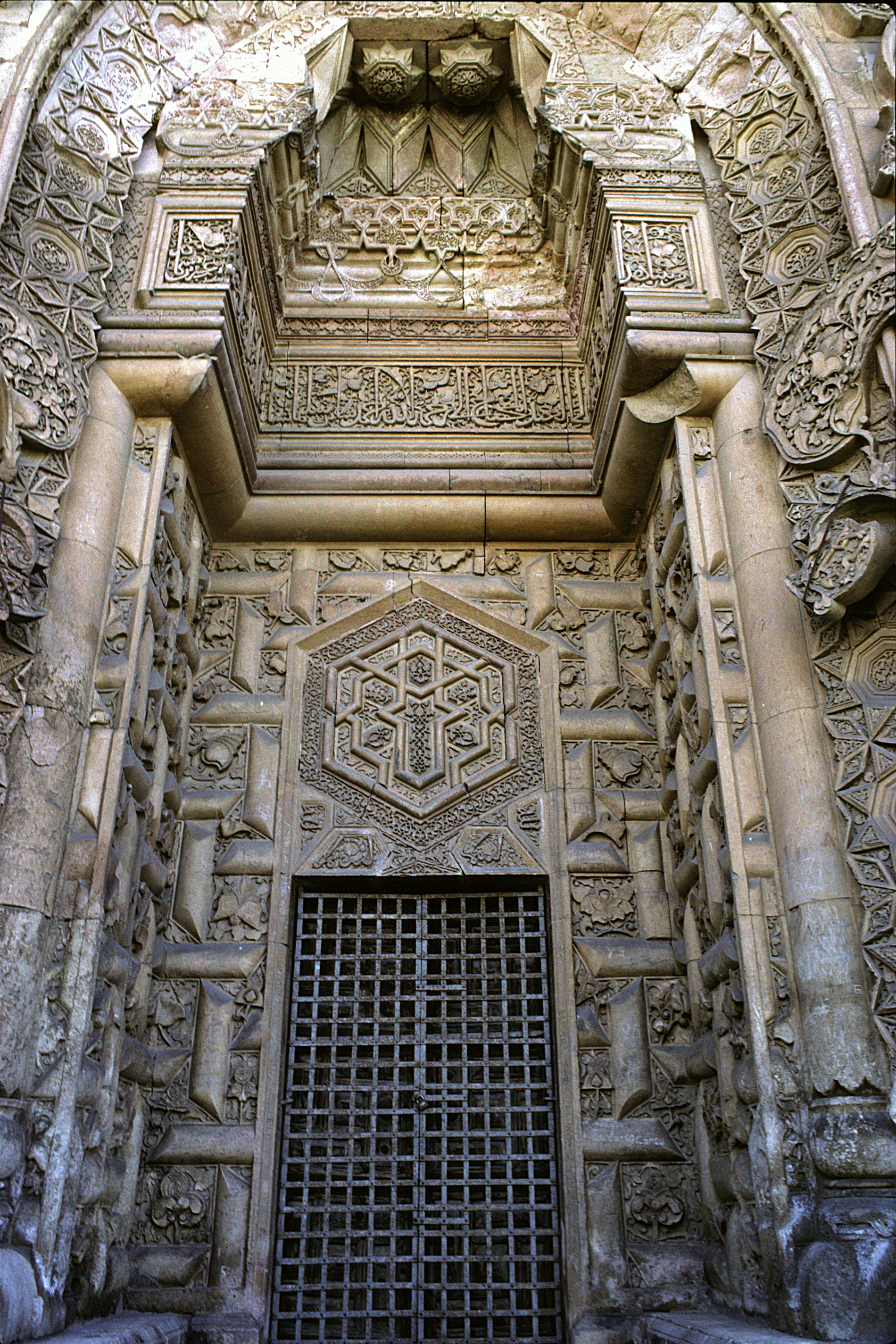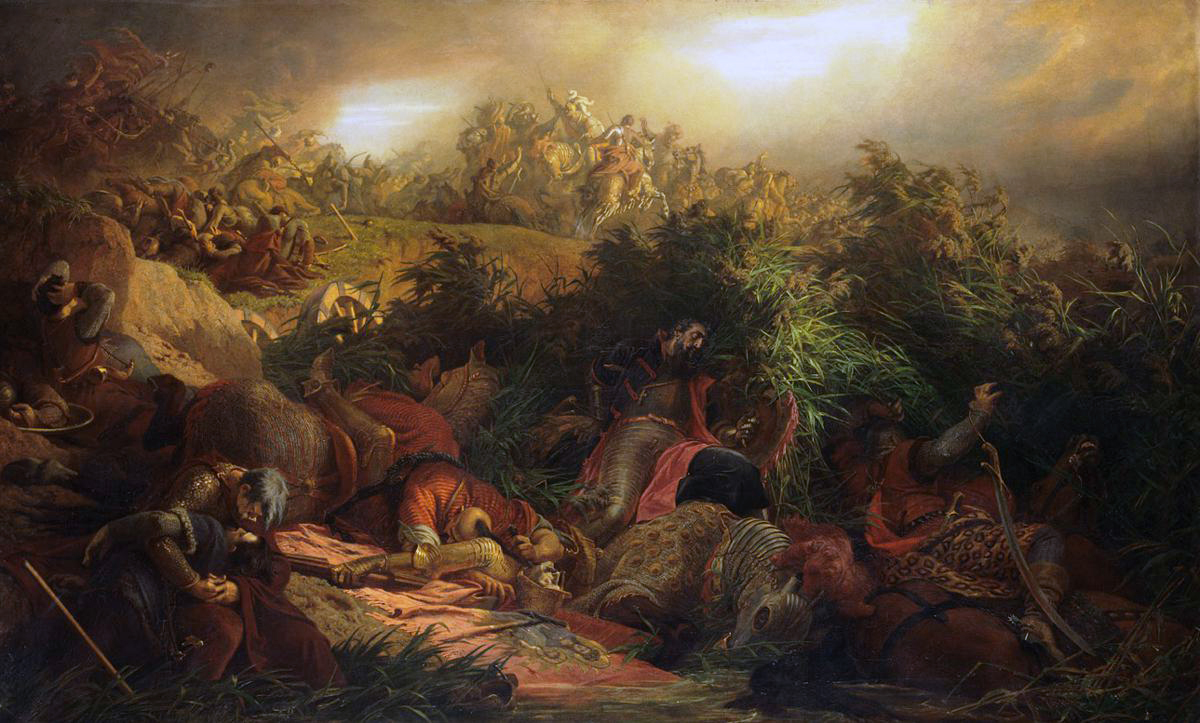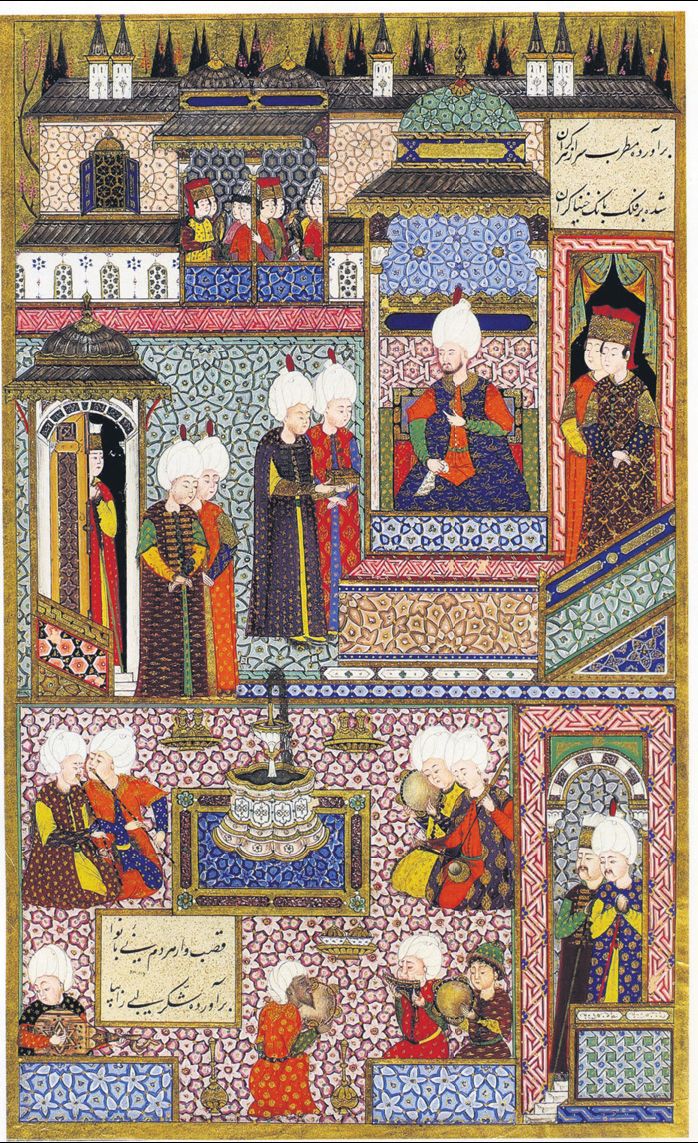|
Hilya
The term ''ḥilya'' (, plural: ''ḥilān'', or ''ḥulān''; , plural: ) denotes both a visual form in Ottoman art and a religious genre of Ottoman-Arabic literature each dealing with the physical description of Muhammad. Hilya means "ornament". They originate with the discipline of ''shama'il'', the study of Muhammad's appearance and character, based on hadith accounts, most notably al-Tirmidhi's ''Shama'il al-Muhammadiyya'' "The Sublime Characteristics of Muhammad". In Ottoman-era folk Islam, there was a belief that reading and possessing Muhammad's description protects the person from trouble in this world and the next, it became customary to carry such descriptions, rendered in fine Islamic calligraphy, calligraphy and Ottoman illumination, illuminated, as amulets. In 17th-century Ottoman Empire, Ottoman Turkey, ḥilān developed into an art form with a standard layout, often framed and used as a wall decoration. Later ḥilān were written for the Rashidun, four Rashid calip ... [...More Info...] [...Related Items...] OR: [Wikipedia] [Google] [Baidu] |
Ottoman Art
Turkish art ( Turkish: Türk sanatı) refers to all works of visual art originating from the geographical area of what is present day Turkey since the arrival of the Turks in the Middle Ages. Turkey also was the home of much significant art produced by earlier cultures, including the Hittites, Ancient Greeks, and Byzantines. Ottoman art is therefore the dominant element of Turkish art before the 20th century, although the Seljuks and other earlier Turks also contributed. The 16th and 17th centuries are generally recognized as the finest period for art in the Ottoman Empire, much of it associated with the huge Imperial court. In particular the long reign of Suleiman the Magnificent from 1520 to 1566 brought a combination, rare in any ruling dynasty, of political and military success with strong encouragement of the arts. The ''nakkashane'', as the palace workshops are now generally known, were evidently very important and productive, but though there is a fair amount of survivi ... [...More Info...] [...Related Items...] OR: [Wikipedia] [Google] [Baidu] |
Shama'il Al-Muhammadiyya
''Ash-Shama'il al-Muhammadiyya'' () is a collection of hadiths compiled by the 9th-century scholar al-Tirmidhi regarding the intricate details of the Islamic prophet Muhammad's life including his appearance, his belongings, his manners, and much more. The book contains 399 narrations from the successors of Muhammad which are divided into 56 chapters. The best known and accepted of these hadith are attributed to Ali, cousin and son-in-law to Muhammad. Another well-known description is attributed to a woman named Umm Ma'bad. Other descriptions are attributed to Aisha, `Abd Allah ibn `Abbas, Abu Hurairah and Hasan ibn Ali. While ''shama'il'' lists the physical and spiritual characteristics of Muhammad in simple prose, in ''hilya'' these are written about in a literary style. Among other descriptive ''Shama'il'' text are the ''Dala'il al-Nubuwwah'' of Al-Bayhaqi, ''Tarih-i Isfahan'' of Abu Naeem Isfahani, ''Al-Wafa bi Fadha'il al-Mustafa'' of Abu'l-Faraj ibn al-Jawzi and ''Al-S ... [...More Info...] [...Related Items...] OR: [Wikipedia] [Google] [Baidu] |
Description Of The Prophet (Hilya Al-nabi), By Hafiz Osman (CBL T 559
Description is any type of communication that aims to make vivid a place, object, person, group, or other physical entity. It is one of four rhetorical modes (also known as ''modes of discourse''), along with exposition, argumentation, and narration. Fiction writing Fiction writing specifically has modes such as action, exposition, description, dialogue, summary, and transition. Author Peter Selgin refers to ''methods'', including action, dialogue, thoughts, summary, scenes, and description. Description is the mode for transmitting a mental image of the particulars of a story. Together with dialogue, narration, exposition, and summarization, it is one of the most widely recognized of the fiction-writing modes. As stated in ''Writing from A to Z'', edited by Kirk Polking, it is more than the amassing of details; it is bringing something to life by carefully choosing and arranging words and phrases to produce the desired effect. Purple prose A purple patch is an over-written pas ... [...More Info...] [...Related Items...] OR: [Wikipedia] [Google] [Baidu] |
Mehmet Hakani
Mehmed or Mehmet is the most common Turkish form of the Arabic male name Muhammad () (''Muhammed'' and ''Muhammet'' are also used, though considerably less) and gains its significance from being the name of Muhammad, the prophet of Islam. Originally the intermediary vowels in the Arabic ''Muhammad'' were completed with an ''e'' in adaptation to Turkish phonotactics, which spelled Mehemmed, Mehemed and the name lost the central ''e'' over time. Final devoicing of ''d'' to ''t'' is a regular process in Turkish. The prophet himself is referred to in Turkish using the archaic version, ''Muhammed''. In Azerbaijani it is ''Məhəmməd''. The name Mehmet also often appears in derived compound names. The name is also prevalent in former Ottoman territories, particularly among Balkan Muslims in Albania, Bosnia and Kosovo. The name is also commonly used in Turkish culture in the form of Mehmetçik, meaning ''little Mehmet'', for unranked soldiers. Given name Mehmed *Mehmed I (1382–1 ... [...More Info...] [...Related Items...] OR: [Wikipedia] [Google] [Baidu] |
Şehzade
''Şehzade'' () is the Ottoman form of the Persian title ''Shah#Shahzadeh, Shahzadeh'', and refers to the male Osmanoğlu family, descendants of an Ottoman sovereign in the male line. This title is equivalent to "prince du sang, prince of the blood imperial" in English. Origin ''Şehzade'' derives from the Persian word ''Shah#Shahzade, shahzadeh'' or ''shahzada''. In the realm of a shah (or shahanshah), a prince or princess of the blood was logically called ''shahzada'', the term being derived from "shah" using the Persian patronymic suffix ''Zadeh, -zādeh'' or ''Zada (suffix), -zada'', meaning "son of", "daughter of", "descendant of", or "born of". However, the precise full styles can differ in the court traditions of each monarchy. Usage in Ottoman royalty In Ottoman royalty, the title ''şehzade'' designates male descendants of sovereigns in the male line. In formal address, this title is used with title ''sultan'' before a given name, reflecting the Ottoman conception of ... [...More Info...] [...Related Items...] OR: [Wikipedia] [Google] [Baidu] |
Suleiman The Magnificent
Suleiman I (; , ; 6 November 14946 September 1566), commonly known as Suleiman the Magnificent in the Western world and as Suleiman the Lawgiver () in his own realm, was the List of sultans of the Ottoman Empire, Ottoman sultan between 1520 and his death in 1566. Under his administration, the Ottoman Empire ruled over at least 25 million people. After succeeding his father Selim I on 30 September 1520, Suleiman began his reign by launching military campaigns against the Christendom, Christian powers of Central and Eastern Europe and the Mediterranean; Siege of Belgrade (1521), Belgrade fell to him in 1521 and Siege of Rhodes (1522), Rhodes in 1522–1523, and at Battle of Mohács, Mohács in 1526, Suleiman broke the strength of the Kingdom of Hungary in the Middle Ages, Kingdom of Hungary. Presiding over the apex of the Ottoman Empire's economic, military, and political strength, Suleiman rose to become a prominent monarch of 16th-century Europe, as he personally led Arm ... [...More Info...] [...Related Items...] OR: [Wikipedia] [Google] [Baidu] |
Şehzade Bayezid
Şehzade Bayezid (; 1527 – 25 September 1561) was an Ottoman prince as the son of Sultan Suleiman the Magnificent and Hürrem Sultan. Early years Bayezid was born in 1527 in Constantinople during the reign of his father, Suleiman the Magnificent. His mother was Hürrem Sultan, an Orthodox priest's daughter, who was the current Sultan's concubine at the time. In 1533 or 1534, his mother, Hürrem, was freed and became Suleiman's legal wife.Kinross, Patrick (1979). The Ottoman centuries: The Rise and Fall of the Turkish Empire. New York: Morrow. . p, 236. He had four brothers, Şehzade Mehmed, Şehzade Selim (future Selim II), Şehzade Abdullah and Şehzade Cihangir, and a sister Mihrimah Sultan. Between 26 November and 8 December 1539, a ceremony was held and celebrating circumcision of Bayezid and his younger brother Cihangir. The entire city and palace were involved in the elaborate event. Representatives from Ferdinand I, Holy Roman Emperor, the French, and the Venetia ... [...More Info...] [...Related Items...] OR: [Wikipedia] [Google] [Baidu] |
Yazıcıoğlu Mehmed
Yazıcıoğlu (, literally "son of the scribe, clerk") is a Turkish language, Turkish surname and may refer to: * Ahmed Bican Yazıcıoğlu (died ca. 1466), Ottoman author * Cafer Tufan Yazıcıoğlu (born 1951), Turkish politician * Cengiz Yazıcıoğlu (born 1953), former Turkish footballer * Muhsin Yazıcıoğlu (1954–2009), Turkish politician * Mustafa Sait Yazıcıoğlu (born 1949), former government minister of Turkey * Ümit Yazıcıoğlu (born 1958), German-Turkish political scientist Settlement * Yazıcıoğlu, Devrek, village in Devrek District, Zonguldak Province, Turkey Turkish-language surnames Patronymic surnames {{surname ... [...More Info...] [...Related Items...] OR: [Wikipedia] [Google] [Baidu] |
Süleyman Çelebi (poet)
Süleyman Çelebi ( – 1422 CE) (pronounced Sulaiman Chalabi), imam of the Grand Mosque of Bursa during the Ottoman Empire, was an Islamic mystic and author whose only known work is ''Wasilat al-Najat''. Commonly known as the ''Mevlidi Sherif - Süleyman Çelebi'', it is the first and most famous of the Turkish-written mawlids on the birth of the Islamic prophet Muhammad. . Chalabi was born sometime between 1346–1351 and died in 1422 CE. Biography He was born in the period of Orhan Gazi. According to some sources, he is the son of Ahmed Pasha, one of the viziers of the Ottoman Sultan Murad I, and the grandson of Sheikh Mahmud Efendi. His grandfather, aka Mahmud Bey, is the grandson of Sheikh Edebali and was one of those who sailed to Rumelia in 1338 under the leadership of Süleyman Pasha, son of Orhan. He received a good education in Bursa in his youth. At that time, the title of "Çelebi" was given to scholars and the elders of the Mevlevi Order. However, there is no ... [...More Info...] [...Related Items...] OR: [Wikipedia] [Google] [Baidu] |
Qadi Iyad
Abū al-Faḍl ʿIyāḍ ibn Mūsā ibn ʿIyāḍ ibn ʿAmr ibn Mūsā ibn ʿIyāḍ ibn Muḥammad ibn ʿAbd Allāh ibn Mūsā ibn ʿIyāḍ al-Yaḥṣubī al-Sabtī (Camilo Gómez-Rivas, Islamic Legal Thought: A Compendium of Muslim Jurists, p 324. Koninklijke Brill NV ), better known as Qāḍī Iyāḍ () (1083–1149), was a Sunni polymath and considered the leading scholar in Maliki fiqh and hadith in his time. In addition, he specialized in theology, legal theory, scriptural exegesis, Arabic language, history, genealogy, and poetry. Biography Iyaḍ was born in Ceuta, into an established family of Arab origin. As a scion of a notable scholarly family, ʿIyad was able to learn from the best teachers Ceuta had to offer. The judge Abu ʿAbd Allah Muhammad b. ʿIsa (d. 1111) was ʿIyad's first important teacher and is credited with his basic academic formation. Growing up, ʿIyad benefited from the traffic of scholars from al-Andalus, the Maghrib, and the eastern Islamic w ... [...More Info...] [...Related Items...] OR: [Wikipedia] [Google] [Baidu] |
Ibn Al-Jawzi
Abu al-Faraj Jamal al-Din Abd al-Rahman ibn Abi Hasan Ali Al-Jawzi also known as Ibn al-Jawzi (16 June 1201) was a Muslim jurisconsult, preacher, orator, heresiographer, traditionist, historian, judge, hagiographer, and philologist who played an instrumental role in propagating the Hanbali school of orthodox Sunni jurisprudence in his native Baghdad during the twelfth-century. During "a life of great intellectual, religious and political activity," Ibn al-Jawzi came to be widely admired by his fellow Hanbalis for the tireless role he played in ensuring that that particular school – historically, the smallest of the four principal Sunni schools of law – enjoy the same level of "prestige" often bestowed by rulers on the Maliki, Shafi'i, and Hanafi rites. Ibn al-Jawzi received a "very thorough education" during his adolescent years, and was fortunate to train under some of that era's most renowned Baghdadi scholars, including Ibn al-Zāg̲h̲ūnī (d. 1133), Abū Bakr al-D ... [...More Info...] [...Related Items...] OR: [Wikipedia] [Google] [Baidu] |
Abu Nu'aym Al-Isfahani
Abu Nuʿaym al-Isfahani (; full name: ''Ahmad ibn ʿAbd Allāh ibn Ahmad ibn Ishāq ibn Mūsā ibn Mahrān al-Mihrānī al-Asbahānī'' (or ''al-Asfahānī'') ''al-Ahwal al-Ash`arī al-Shāfi`ī'', died 1038 CE / AH 430) was a medieval Persian Shafi'i scholar and one of the leading hadith scholars of his time. His family was an offshoot of the aristocratic House of Mihran. Biography Birth and Education Born in Buwayhid era Isfahan, his first teacher was his own grandfather who was a Sufi master, Sheikh Muhammad ibn Yusuf ibn Ma;dan al-Banna' (d. 365/976), who was the spiritual leader of a school of Sufism in Isfahan, which continued to flourish during the lifetime of Abu Nu'aym. Under his father's lead and guide, he began his scholarly career at an early age. As he got older, he would widely travel and visit Hejaz, Iraq, Syria, Khurazan and other places. He possessed ijaza in hadith from all major scholars of his time. Teachers Abu Nu'aym had numerous teachers, his most famo ... [...More Info...] [...Related Items...] OR: [Wikipedia] [Google] [Baidu] |




